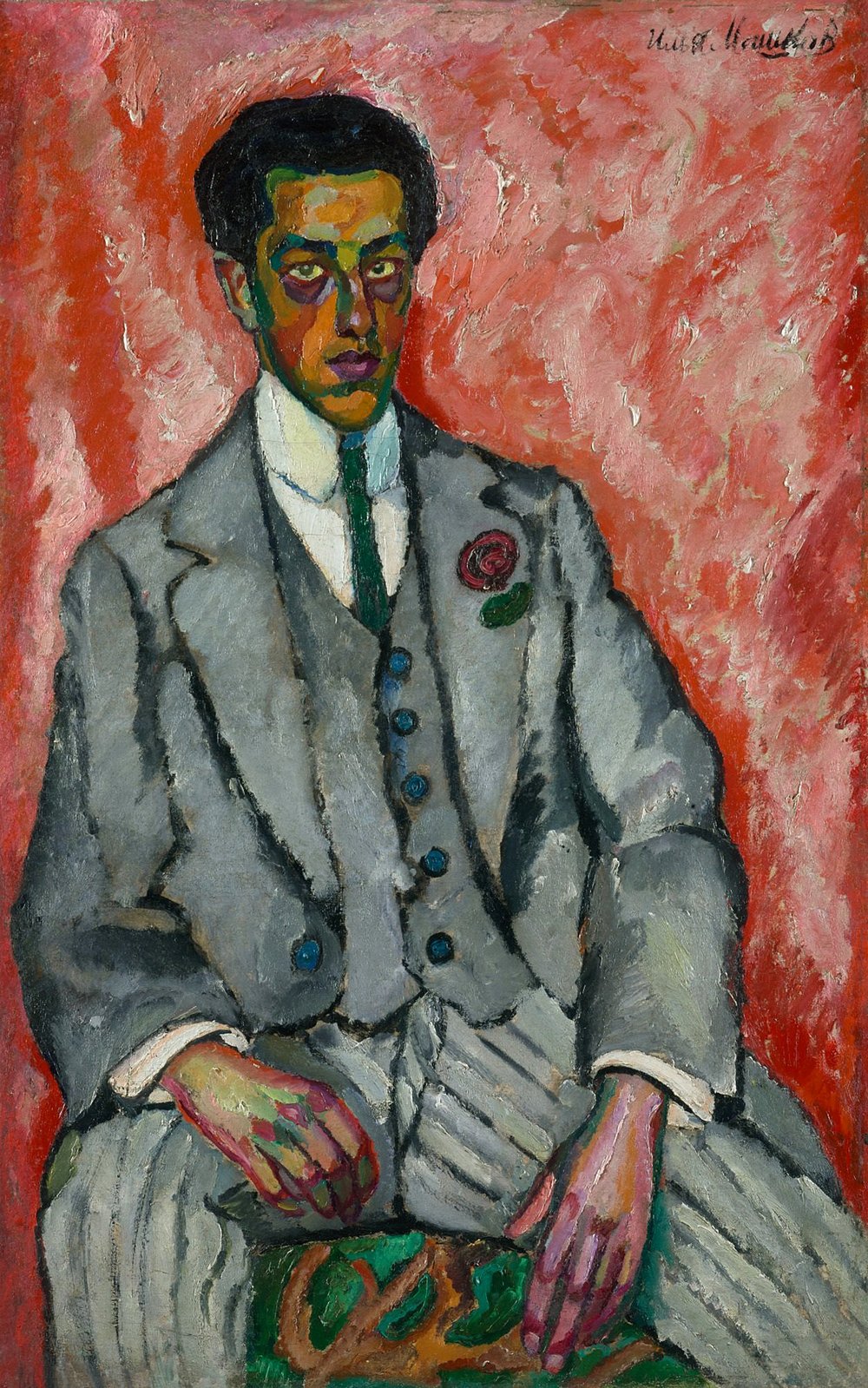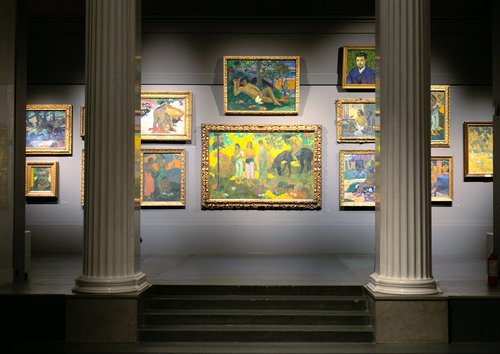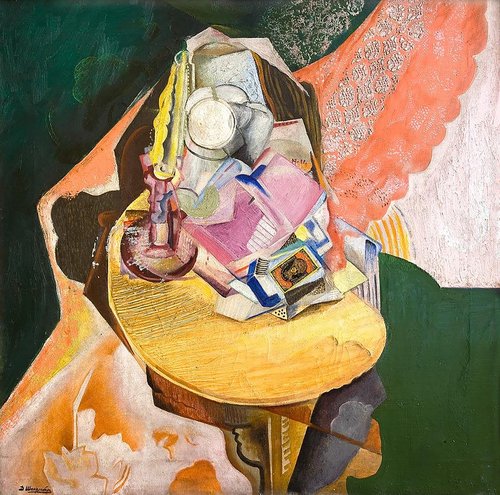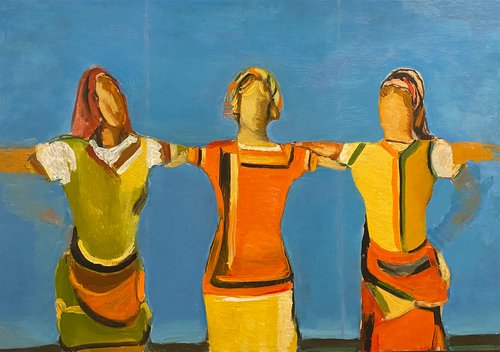Ilya Mashkov: Apostle of the Soviet Paradise

Ilya Mashkov. Portrait of E.I. Kurlyand, 1909. Courtesy of State Tretyakov Gallery
The largest and most ambitious retrospective exhibition ever held of modernist and soviet Russian painter Ilya Mashkov is currently on view at the State Tretyakov Gallery in Moscow. ‘Ilya Mashkov. Avantgarde. Kitsch. Classic’, examines Mashkov’s controversial artistic journey from the avant-garde to socialist realism.
Ilya Mashkov (1881–1944) is a hero suitable for any regime. For the left he is an avant-gardist who began his career in one of the most radical Russian associations, the Bubnovy Valet (Eng. Jack of Diamonds). Its members shocked tastes by turning to lowbrow popular fairground art and kneading brightly coloured paint in a kind of frenzy á la Paul Cézanne (1839–1906) the father of modernist painting. For the liberal bourgeoisie, Mashkov is an expensive, blue-chip artist with a solid reputation. He crafted sumptuous and meticulous still lifes in luxurious interiors. For arch conservatives, Ilya Mashkov is the singer of the totalitarian epoch of socialist realism with altars of party leaders transformed into deities: Lenin, Stalin, Marx and Engels.
Fortunately, the curators of the exhibition have avoided the blockbuster formula with spectacular displays of textbook works. They also avoided political opportunism, presenting quite objectively the authoritarian and somewhat infernal attempts by Mashkov – in the spirit of the disturbing stories by Russian writer Andrey Platonov – to create a Soviet paradise in the 1930s for educating the masses about art. Instead, brilliantly curated by Kirill Svetlyakov and Natalya Vasilyeva, the show resembles an academic monograph or dissertation.
Almost the entire oeuvre of the artist is displayed throughout the vast exhibition space. There are around two hundred paintings and drawings by Mashkov on loan from twenty-seven museums across Russia, the Minsk National Museum of the Republic of Belarus, and four major private collections. Led by Igor Chirkin, the exhibition design team have created a winding corridor of walls in colours evocative of the study halls of avant-garde art institutes like VKhUTEMAS, where Mashkov once taught. Along these walls, curator Kirill Svetlyakov has put together some clever visual themes and leitmotifs which emanate from the artist’s work. For example, on one wall he has hung together nude paintings taken from different periods, so we are able to trace how avant-garde Matissean colour with broad coloured washes gave way to complex tonal development in Mashkov’s socialist realist period. Or there are landscapes with brightly coloured, naïve backgrounds placed side by side. According to curator Svetlyakov, during the ‘Jack of Diamonds’ period (1910–1920s) the artist was fascinated by naïve vernacular kitsch art. He bought trays with folksy ornaments and introduced them into his landscapes. In some rows on the wall there are paintings from both the 1910s and the 1930s showing how he developed the theme of draperies from early Cézannist still lifes, how open colour and powerful formal construction gave way to realistic illusionism.
The curator’s professional, analytical approach is convincing and he shares his scholarly ideas about the essence of Mashkov’s painterly method at different stages of his creative career with no exaggerated emotion. And inspite of this you ulimately believe with a certain level of conviction that: yes, artist Ilya Mashkov is a true maestro of the highest order.
However, there are also some copies of documents on display in the exhibition which express something of the noise of the times and today provoke a certain response in viewers as they reveal what ultimately became a compromised result of life in art of someone who otherwise was an exceptionally talented artist.
There is an impressive design for the organisation of public cultural institutions which Ilya Mashkov created in 1918, a time of energetic renewal of the world along communist lines, of Proletkult and other social organs of a proletarian supervision of art and culture. The design resembes a Masonic lodge: in the centre a kind of altar for the council of artists and workers in the plastic arts of the city of Moscow surrounded by panels which would have been inscribed with the number of delegates. These are the servants of a new cult. At the edge, are the unions of sculptors, painters, decorators, the owners of private museums and collections among others. It is fascinating to observe how leftist fervour – or enthusiasm - is fused with rightist atavism to create a totalitarian order, modelled on a religious sect from which the sacred core has been removed. Mashkov’s legendary workshop was organised in the spirit of a mediaeval brotherhood combined with the desire for revolutionary reforms, which curator Svetlyakov describes as the ‘workshop of the new Renaissance’. VkhUTEMAS’ professor Ilya Mashkov called his students apprentices, demanding that they live and work as a family in his studio, and this collectivism helped the workshop survive all the upheavals of the 1920s–1930s with artists being accepted into it until Mashkov’s death. A co-operative that Mashkov created in the 1930s in his native village of Mikhaylovskaya in the Volgograd region in the south of Russia was even more like a totalitarian sect. Mashkov organised residents of the village into labour brigades and demanded they help to build devices for the painting of panoramas. In what used to be the village’s church before the Soviet times, he founded a club with hobby groups. He intentionally pushed people towards what he saw as a bright future and communist atheistic paradise.
In my view, Mashkov’s weird, uncompromising service to this new cult did not allow his exceptional talent as a painter to become fully realised. Mashkov first put on the chains of the Proletkult, then of socialist realism and the cannibalistic party ideology. It did not allow him to be flexible and protean, or to fully manifest his artistry and his innate capacity for improvisation. His style ossified. In the first half of his career, he had created complex analytical Cézannesque still lifes and portraits using interesting experiments in a cubo-futurist key such as his multi-faced portrait of artist Adolf Milman 1916–1917 which is surely a genuine masterpiece of both surrealism and Cézannism. Then, later he gradually he moved towards a viscous, dense style with decorative colouring of forms and frozen, stereotypic colour relationships. As a result, in the 1930s he painted panoramas with faceless collective farmers and sumptuous still lifes with pretzels from which the USSR coat of arms was baked, as well as a still life altar with CPSU leadership replacing biblical images. With their elaborate clumsy rhetoric, these late works recall the typical plaster wreaths and horns of the pavilions of the great Soviet paradise for workers and collective farmers at the VDNKh USSR exhibition centre. Taking into account his zealous service to the cult of this new atheistic religion, Mashkov can be called an apostle of the Soviet paradise.
The artist died in 1944, and only rarely towards the end of his life does that force of creative living genius manifest itself in portraits and still lifes with shining decanters that reminds us that Ilya Mashkov was a contemporary of both Kazimir Malevich (1879–1935) and Konstantin Somov (1869–1939).
Ilya Mashkov. Avantgarde, Kitsch, Classic
Moscow, Russia
17 June – 26 October 2025
















